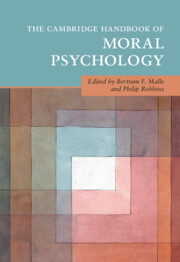Book contents
- The Cambridge Handbook of Moral Psychology
- Cambridge Handbooks in Psychology
- The Cambridge Handbook of Moral Psychology
- Copyright page
- Contents
- Figures
- Tables
- Contributors
- Preface
- 1 Modern Moral Psychology
- Part I Building Blocks
- Part II Thinking and Feeling
- Part III Behavior
- Part IV Origins, Development, and Variation
- Part V Applications and Extensions
- 21 Criminal Law, Intuitive Blame, and Moral Character
- 22 Moral Dimensions of Political Attitudes and Behavior
- 23 Moral and Religious Systems
- 24 Lessons from Moral Psychology for Moral Philosophy
- Index
- References
22 - Moral Dimensions of Political Attitudes and Behavior
from Part V - Applications and Extensions
Published online by Cambridge University Press: 20 February 2025
- The Cambridge Handbook of Moral Psychology
- Cambridge Handbooks in Psychology
- The Cambridge Handbook of Moral Psychology
- Copyright page
- Contents
- Figures
- Tables
- Contributors
- Preface
- 1 Modern Moral Psychology
- Part I Building Blocks
- Part II Thinking and Feeling
- Part III Behavior
- Part IV Origins, Development, and Variation
- Part V Applications and Extensions
- 21 Criminal Law, Intuitive Blame, and Moral Character
- 22 Moral Dimensions of Political Attitudes and Behavior
- 23 Moral and Religious Systems
- 24 Lessons from Moral Psychology for Moral Philosophy
- Index
- References
Summary
This chapter of the handbook discusses the moral dimensions of political attitudes and behavior. The authors argue that a person’s political views – both at the level of political ideology as a whole and views on specific matters of economic and social policy – are profoundly shaped by their beliefs about right and wrong. These political views in turn drive people’s political behavior, not just at the ballot box or on the campaign trail, but in the community more generally. One downside of the way in which moral convictions fuel political attitudes and behavior is that they tend to interfere with productive communication across partisan divides, fueling a kind of animosity that stifles cooperation and compromise. Divergence in people’s moral convictions, then, leads inexorably to political polarization and gridlock. To address this problem, the authors discuss a number of potentially promising interventions, some of which target individuals’ attitudes (e.g., promoting empathy, reducing negative stereotypes), and others that aim at improving the quality of interpersonal relationships (e.g., increasing contact, fostering dialogue across political divides).
- Type
- Chapter
- Information
- The Cambridge Handbook of Moral Psychology , pp. 549 - 574Publisher: Cambridge University PressPrint publication year: 2025

